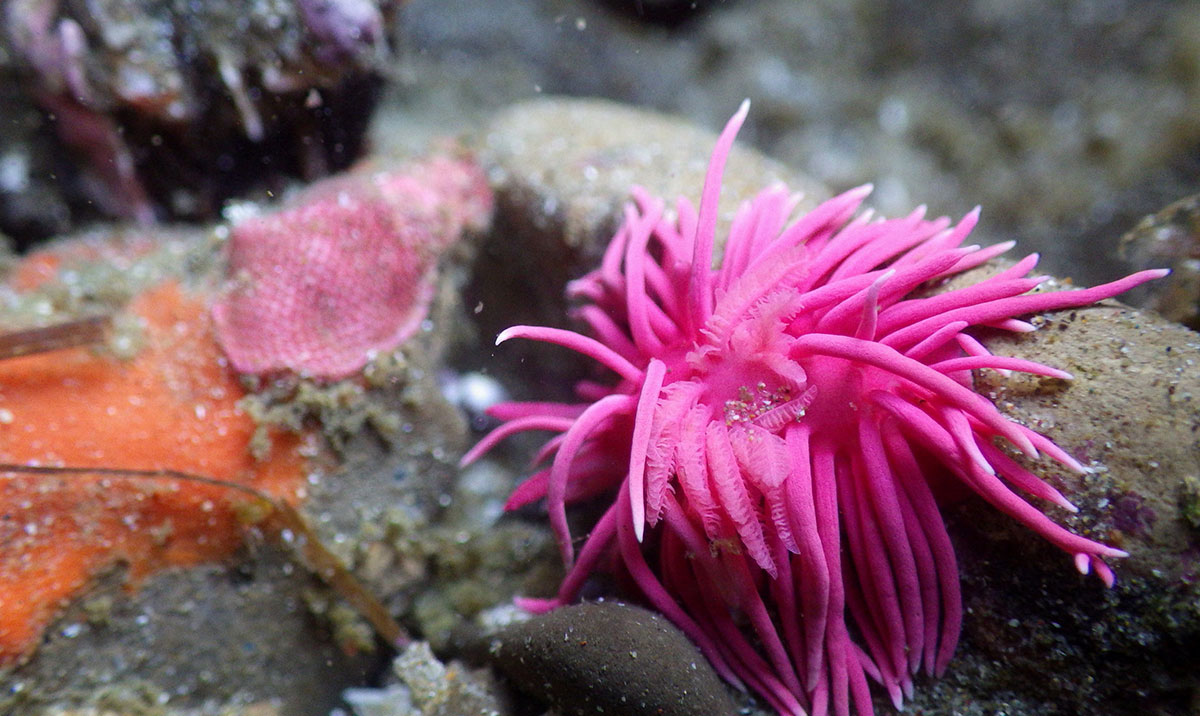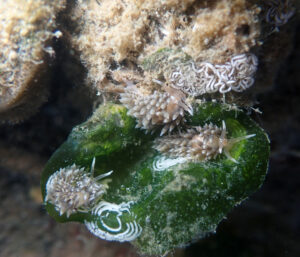Update: This story was revised on May 11 to add information about a Hopkins’ rose sighting in southern Oregon.
Terry Gosliner, the curator of invertebrate zoology at the California Academy of Sciences and one of the world’s leading authorities on the soft-bodied marine invertebrates known as nudibranchs, has the confident enthusiasm of someone who loves sea slugs and believes you should too. So he’s standing, specimen jar in hand, gazing affectionately at a hot pink slug floating lifelessly in alcohol, and assuring me it’s even more colorful in the wild. Preserving liquid may have robbed the creature of brilliance, but it does not steal its importance: This is a fine specimen of California’s nudibranch du jour, an alien to our coast whose rise Gosliner seems to have successfully predicted.
At first glance, the slug looks remarkably like a child’s plastic anemone toy. Gosliner gently points out its “furry” papillae, the pink-colored finger-like protrusions on its back. As the flamingo takes its rosy pigment from shrimp, this nudibranch steals its color from its prey, a pink coral-like filter feeder. Gosliner tilts the jar forty-five degrees so the nudibranch hovers in the alcohol and shows off a flat locomotive “foot” on its bottom side, and a halo shaped gill ring on its tail end. “Naked gilled” nudibranchs are snails that have lost their shells in the course of evolution, in favor of defense strategies like vibrant coloration that warn of their toxicity. As the specimen rotates slowly, a pair of feathery rhinophores — sensory tentacles that help it smell, taste, and navigate its benthic world — branch out from its head like an antenna.
At low tide on the North Coast right now, the tidepools teem with these little guys. “A couple of my colleagues were tidepooling recently on the Mendocino coast and found 118 rose nudibranchs in an hour where before this warm year we would only see two or three in that area,” Gosliner says. “This is not normal business as usual.”
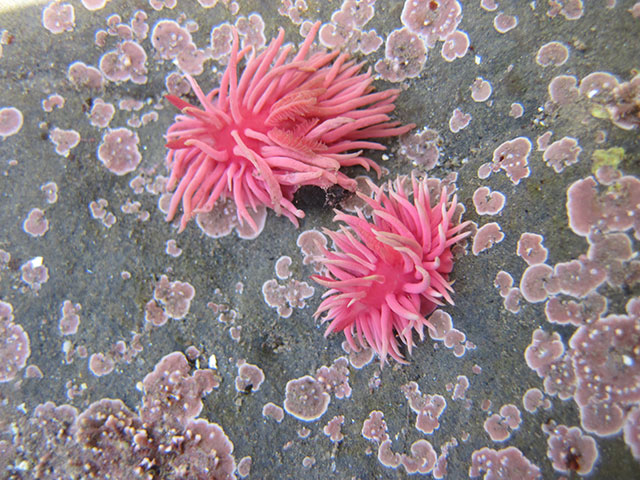
The pink sea slug, the Hopkins’ rose nudibranch (Okenia rosacea), normally dwells in the warm waters of Southern California but is hardly ever spotted further north. Or, at least, it was hardly ever spotted further north. This winter, Hopkins’ rose bloomed along the northern California coast in record numbers. Researchers have started tracking the nudibranchs’ distribution to see if there’s a connection to climate change-driven ocean temperatures.
Some scientists have warned of the “the rise of slime” in our future oceans. The scenario, conjuring images of squishy masses climbing out of the sea like a bad sci-fi film, predicts a time when warming and acidic conditions allow hardy, soft-bodied invertebrates — like jellyfish, squid, starfish, and nudibranchs — to replace the less adaptable fish. Gosliner and his colleagues suggest that some of that slime will be pink, and this recent bloom could be a harbinger of the future.
“A couple of my colleagues were tidepooling recently on the Mendocino coast and found 118 rose nudibranchs in an hour where before this warm year we would only see two or three in that area. This is not normal business as usual.”
Gosliner and a team of marine experts predicted widespread nudibranch range shifts tied to warming ocean temperatures in a 2011 report in the journal Limnology and Oceanography. Their climate models compared historical range distribution data of 56 nudibranch species in relation to sea-surface temperature and height. The models showed that where warm temperatures, northward ocean currents, and weak upwelling all overlap, southern species will move northward. The Hopkins’ rose, a southern species, arrived this winter to seemingly confirm the prediction.
“It’s a little scary, actually, when we’re making predictions about the future and suddenly the profound changes we envisioned are coming to pass,” Gosliner says. “It’s really exciting to see from a scientific standpoint, but very alarming to see as someone who worries about climate change.”
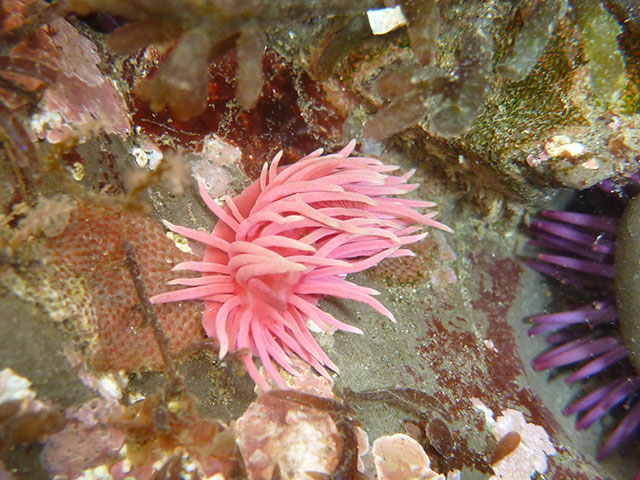
Hopkins’ rose nudibranchs aren’t particularly fast, but they travel well. They begin their odyssey in spiral ribbon-like egg sacks laid counterclockwise on the ocean floor. The eggs then hatch into microscopic larvae that float passively until they are swept into a warm shallow tidal zone. There they settle to the bottom of a pool and grow into showy but stationary adults that live for about a year.
The larval migration is largely up to ocean currents and upwelling on the central California coast. But both of those have been different recently. Winds that blow from the north and trap warm water near the equator slackened after last summer, and warm equatorial water “sloshed” back up north. Under normal conditions, the same winds also push away surface water and churn up deep, cold, nutrient-rich water from down below. The upwelling slackened, too.
Without the cold water that serves as a check on their range, rose nudibranch larvae traveling up the coast have been able to drift into northern tide pools. The bloom started in early February. In March, NOAA reported record-high sea surface temperatures and weak upwelling leading to a severe drop in the California Current’s primary productivity. The report explained that major primary producers — tiny, shrimp-related copepods – make up the energy base of West Coast food chain, and their decline may explain the California sea lion pups and Cassin’s auklets found dying and emaciated in large numbers in recent months. So far the nudibranchs have shown to be a reliable predictor of this transition in marine productivity.
Hopkins’ rose doesn’t feed on copepods; like most nudibranchs, it is an extremely picky eater. It eats just one filter-feeding animal called the “pink encrusting bryozoan” (once known as Eurystomella bilabiata, now Integripelta bilabiata). Bryozoans, commonly called moss animals, are superficially similar to coral. They both eat tiny organic particles floating in the water, they both form colonies of interconnected individuals, and they both have hard, boxy cells that house a single organism (for coral this organism is called a polyp and for bryozoans it’s called a zooid).
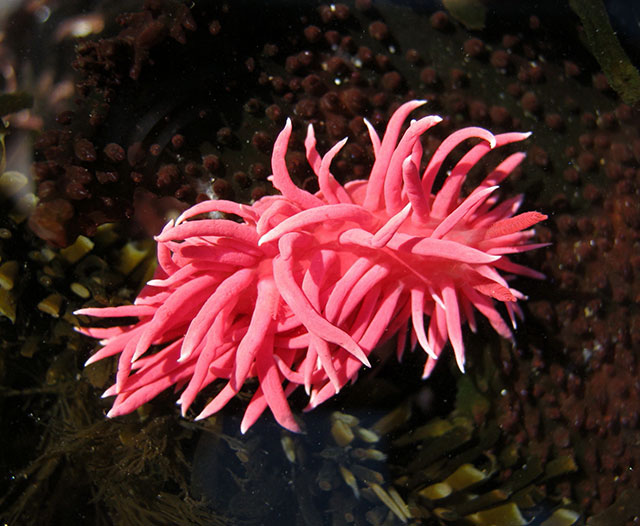
To human observers Hopkins’ rose may look like a small pink splotch inching its way along the rocky patchwork, but to a pink bryozoan zooid growing around half a millimeter long, the sea slug is a ravenous carnivore, 20 times its size, equipped with mouthparts engineered to be the stuff of bryozoan nightmares. “One of the Hopkins’ rose’s really cool adaptations it is that they’ve modified their teeth to look like little crochet hooks,” Gosliner says, curling his index fingers. “They use those hooked teeth to reach into the bryozoan and pull out the individual.”
And Jeff Goddard, a marine biologist at the University of California at Santa Barbara, and an expert in the finicky diets of nudibranchs, says that despite their picky diets, nudibranch blooms start to have dramatic effects on intertidal diversity. The bryozoans that nudibranchs prey on are part of an “encrusting” community on the intertidal rocks, including the sea squirts, bryozoa, and hydrozoa. “When you turn over a rock, it’s this incredibly diverse mosaic,” Goddard says.
The encrusters feed by catching organic particles suspended in the water, and as they do so they filter the water, allowing other marine life to thrive. Hopkins’ rose nudibranch blooms mean declining pink encrusting bryozoan populations, and if the pink encrusting bryozoan suddenly disappear, the encrusting “patchwork” could get overrun with a sponge, hydra, or other bryozoan that would not normally fill the pink bryozoan’s niche, Goddard says. Another possibility is the niche could go unfilled, and system would lose an important filter feeder.
The fact that most nudibranchs are specialized eaters means each one is feeding on a different animal in a different level of the food chain. Where there are a variety of nudibranch species in a marine environment, it shows the ecosystem is in balance. “If there are one or two species that are dominant, that tells us something really unusual is going on,” Gosliner says. “[Nudibranchs] are the canary in the tide pool coal mine. I usually pay attention to what the nudibranchs are telling me.”

The nudibranchs have spoken up in the past. In 2011, Goddard, Gosliner, and UC Santa Cruz emeritus biology Professor John Pearse published a study in the journal Marine Biology that described a hostile nudibranch takeover playing out in Marin. Since the late 1970s, the species Phidiana hiltoni (also called Phidiana pugnax, a delightful note on its pugnacious nature) had expanded its range from Monterey to Duxbury Reef, paralleling this winter’s Hopkins’ rose expansion. Bearing jet-black cerata with white and crimson tips that cover its ghostly body, P. hiltoni was an equally vibrant specimen — and also an aggressive killer. The cannibalistic nudibranch bit, attacked, dismembered, and slurped up native sea slugs left and right. By watching the nudibranchs P. hiltoni attacked in the lab, researchers determined native species to be vulnerable or not vulnerable to predation from the voracious invader. P. hiltoni’s full impact could then be assessed by looking at historical population counts of susceptible species starting the late 1960s. They found, “the nudibranchs vulnerable to attack by P. hiltoni declined an average of two-thirds at Duxbury Reef since its arrival.”
Phidiana has an important lesson for the scientists dealing with today’s Hopkins’ invasion: they were on a doomsday trajectory, but then … they seemed to have stopped.
“What we see now is that it’s still around but its population structure stabilized,” Gosliner says. “It’s no longer the dominant nudibranch and we’re seeing other nudibranchs coming back. It disrupted things for the better part of 10 years but now it seems to be coming into equilibrium.”
Gosliner says he thinks that once it ate itself out of its prey, Phidiana’s reproductive success dropped. “But now if the native nudibranchs bound back, Phidiana could go through another cycle,” he says. “Over time the fluctuations may become more stabilized but I suspect it’s here to stay.”
Gosliner and Goddard say that Hopkins’ rose may follow a similar path. Boom and bust cycles are commonplace in natural populations, so it can be hard to see the end of the trend from the middle of it. But scientists, just like locals living on the coast, are observing their marine backyard change in real time, in ways they’ve never seen before.
This May, Richard Emlet, a biologist at the University of Oregon, spotted Hopkins’ rose in Sunset Bay State Park on a class field trip. This was the first Hopkins’ rose sighting in Oregon since Goddard found one there during the strong El Niño of 1998, and only the second verified sighting in Oregon ever. “So now the question is, did it get farther north to the Olympic Peninsula?” Goddard says. “And of course, will it reproduce in Oregon and stick around?”
This June, Goddard will travel from his home base in Santa Barbara up to northern California and southern Oregon to see if any of the other marine invertebrates he studies have made it up there. He’s especially curious about a banana yellow nudibranch called the white-spotted sea goddess (Doriopsilla albopunctata) which, like Hopkins’ rose, has been “lurking” at its know northern range limit in Mendocino County this year.
“Many of the animals I’m interested in will probably be fine, they might just shift their range,” Goddard says, “but it’s pretty disconcerting to think about the other species — the seabirds and salmon and steelhead trout, for example — that will have a harder time of it. They’re all indicating what we’re doing to the climate, which to me is incredible to think about.”
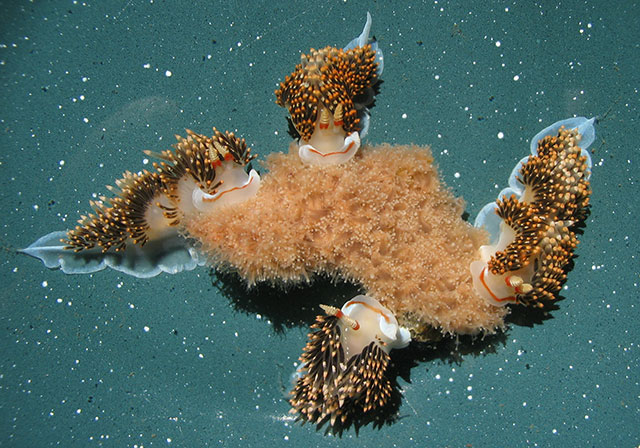
There are a few other nudibranchs, like the purple and orange Spanish shawl, and the bulbous California sea hare, that have been spotted in uncharacteristically northern latitudes. Goddard says there’s a bright side – literally – to the nudibranchs expanding. He says we should be “grateful” to have the little invertebrates as climate signals because they aren’t wreaking too much havoc on the large scale, and their range shift isn’t as much a tragedy as starving pelagic birds and sea lions. “I don’t think nudibranchs will have drastic effects higher up on the food chain,” he says “and because they’re short lived and have these bright colors, I like to think of them as indicators. This is a classic example because normally you have to have your nose in the water to pick out the kinds little organisms we look for, but you can spot [Hopkins’ rose] 15 feet away.”
They are also excellent subjects for future study. Gosliner and his team at the Academy are currently pulling DNA from Hopkins’ rose specimens to see if they’re more closely related to southern populations or to the small historical northern groups. The rose bloom has primed the marine biology community to be on the lookout for subsequent range shifts.
And the scientists hope to bring citizens deeper into efforts to track marine invertebrate range shifts by adding new features like species distribution maps to iNaturalist, the Academy’s citizen science smartphone app. The timing and location of these accumulated records could help scientists explain population functions at particular sites. For Northern California nudibranch enthusiasts, good places to spot the Hopkins’ rose bloom include Scott Creek Beach, Pigeon and Pillar Points, Fitzgerald Marine Reserve, and Duxbury Reef. And while you’re observing, Goddard says … maybe you’ll see other changes, too.
“It’s always struck me that their distribution seems to mirror the red abalone,” Goddard says. “I’d bet that over the next few decades we might see a 2015 class of red abalone, some limpets, and a whole slew of other animals that have larval stages being transferred north.”
Though today red abalone are most abundant north of San Francisco, Goddard explains that the red abalone and Hopkins’ rose historically have had a very similar range and they still share a northernmost range limit, with reds only rarely moving into southern Oregon. “I think there’s a good chance that late 2014 or early this year, [red abalone] larvae were transported to southern Oregon,” he says. Once they settle there they will grow large and noticeable, and perhaps capture the public’s attention in upcoming years. Time will tell if red abalone in Oregon will be the Hopkins’ rose of NorCal, but for Goddard, the northern rose bloom is announcing the trend.

